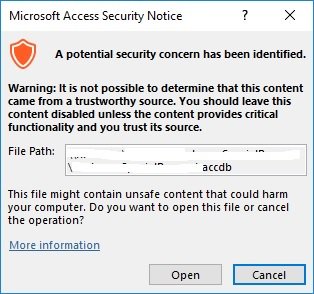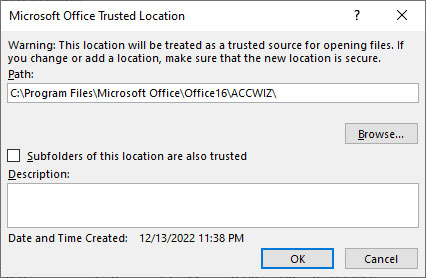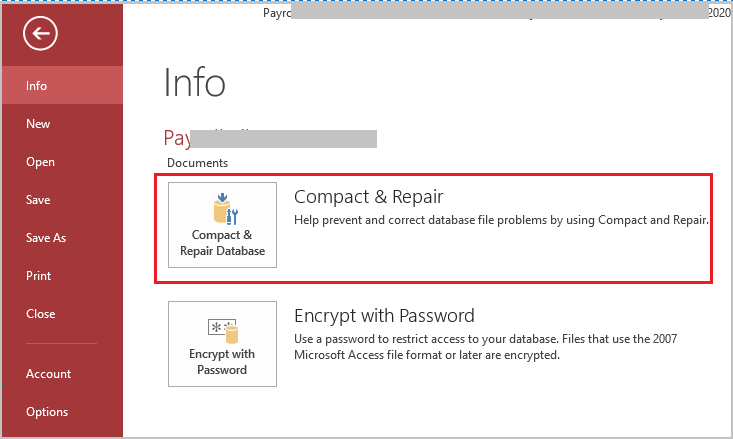Users may encounter a Microsoft Access security notice error when trying to import Excel files into Access or when they open a database from an untrusted location. This warning message is a proactive measure by the PC to safeguard the user’s data. Ignoring this security notice could compromise the database and the integrity of the user’s data.

In this blog, we’ll delve into the details of a potential security concern has been identified Access error and most importantly how to solve it.
Let’s embark on a journey…
Free MS Access Database Repair Tool
Repair corrupt MDB and ACCDB database files and recover deleted database tables, queries, indexes and records easily. Try Now!
By clicking the button above and installing Stellar Repair for Access (14.8 MB), I acknowledge that I have read and agree to the End User License Agreement and Privacy Policy of this site.
Quick Fixes:
- Add The File to The Trusted Location
- Change the Macro Security Settings
- Using the Registry key
- Updating Access Software
- Create a Trusted Location for your Access Project using the Package and Distribute Feature
- Run Compact and Repair
What Is Microsoft Access Security Notice a Potential Security Concern?
The security warning is an error that pops up whenever you try to open a database from an untrusted location. The message throws security alerts when there is potentially unsafe, active content in the database you open.
Suppose, the file might contain a signed or unsigned macro with an invalid signature. In such cases, the security message appears by default to alert you about the problem and to protect your data.
Common Factors of this Error
This error may occur on your computer screen under these circumstances:
- MS Access runtime file has recently been updated.
- Maybe the program file is not located in a trusted location.
- Using an outdated version of Access.
- Corrupted database.
How to Remove a Potential Security Concern Has Been Identified Access Error?
Follow the below step-by-step method to troubleshoot this peculiar error.
Method 1- Add The File to The Trusted Location
The very first solution that you need to try is to add the database to the trusted location. As already said, navigating the database from an untrusted location leads to this error.
Here’s how you can add the DB to a trusted location:
- Go to the File >> Options.
- Then, click on the Trust Center >> Trust Center Settings option that you can see on the right side.

- After that, click on the trusted locations & add a new location.
- Now, Browse and choose the location & save.

Also Read: Fix ‘Cannot Open or Run Macro’ (Error 32002) in Access Instantly
Method 2- Change the Macro Security Settings
By changing the macro security settings, you can get rid of the Microsoft Access security risk.
- First of all, go to the File, and then tap on Options.
- Then, click on the Trust Center >> Trust Center Settings option.

- Under the Trust Center dialog box.
- Click on Macro Settings and mark the checkbox “Enable all macros (not recommended; potentially dangerous code can run).”
Method 3- Using the Registry key to Fix Microsoft Access Security Notice Turn Off
This step will create a Trusted Location for MS Access 2010 because version 14.0 is the Access 2010 version. But if you are unaware of what version of MS Access your client is using or if you want this to work for multiple clients using various versions.
The registry doesn’t make any issue if you create any registry key for a version that doesn’t exist. So, you can simply duplicate the key mentioned above for each version that has very little chance to have.
Here is the list of office versions, so now you can easily know about your Access Version.
Access 97 (version 8.0), Access 2000 (version 9.0), Access 2002 (version 10.0), Access 2003 (version 11), Access 2007 (version 12.0), Access 2010 (version 14.0), and Access 2013 (version 15.0).
A version prior to 2007 is not considered above, so we need to include these version numbers 11.0, 12.0, 14.0, 15.0. Here is the above registry key copied to include all four of these versions.
[HKEY_CURRENT_USER\Software\Microsoft\Office\11.0\Access\Security\Trusted Locations\Location20]”Path”=”C:\\Database\\””Description”=”My Database location”
[HKEY_CURRENT_USER\Software\Microsoft\Office\12.0\Access\Security\Trusted Locations\Location20]”Path”=”C:\\Database\\””Description”=”My Database location”
[HKEY_CURRENT_USER\Software\Microsoft\Office\14.0\Access\Security\Trusted Locations\Location20]”Path”=”C:\\Database\\””Description”=”My Database location”
[HKEY_CURRENT_USER\Software\Microsoft\Office\15.0\Access\Security\Trusted Locations\Location20]”Path”=”C:\\Database\\””Description”=”My Database location”
Save this text in Notepad with a name like RemoveSecurityWarning.reg and run it by double-tapping.
Method 4- Updating Access Software
Keeping your Microsoft Access program up-to-date is the crucial step in addressing the security notice. Visit the official Microsoft website to install the latest updates.
Also Read: Fix Cannot Open Database It May Not Be a Database. (Error 3049)
Method 5- Create a Trusted Location for your Access Project using the Package and Distribute Feature
If you are an Access Developer who is annoyed a lot with the security warning then these steps will surely give you relief. Well, if you are distributing MS Access projects to clients, it’s better to use the handy package solution that allows you to choose the folder your database is installed in and enter some custom registry keys.
Follow these steps:
- To make an MS Access installer package, tap on the File menu and hit the Save & Publish option. After that, on the right pane, hit the Package Solution button.

- This will open the launch Package Solution Wizard. Browse to choose your destination folder and click the next option.

- After that, you see the Installation Options page opened.
– In the File to Package field choose your Access file.
– Within the Root install folder field choose System Drive option.
– In the Install sub-folder field assign a name to the folder, you want your project to get installed into the client’s PC. But make sure the path should be the same as you feed later in the registry key. – You can try other options on this page as per your need and then tap on the Next option.

- This will open the page with a section called Additional Registry Keys. Here you need to enter the key that will make the folder where your Access projects get installed into a Trusted Location.
Add trusted location:
– go to the section near the bottom of the page and tap to the Add button.
– In the Root column, choose Current User.
-Within the Key column, enter key such as Software\Microsoft\Office\14.0\Access\Security\Trusted Locations\Location20
(Note: here 14.0 is for Access 2010 version. If you are using a different version, enter some appropriate version number or you can also add additional keys for each of the versions.)
– In the Name, column enter the Path
– within the Value column, enter the Path you choose earlier, like C:\Database\
– After entering the key, tap to the Next button.
- Now must have reached the final page of the Package Solution Wizard. To assign some Product Name for your project enter whatever information you wish on this page. At last press the OK option.
- After tapping the OK option, it will ask you to save the wizard settings. So save it properly so that you can reuse it again for the next time.
Now when you install the Access database on your client’s PC, they won’t get any irritating Microsoft Access Security Notice each time they run their application.
Method 6- Run Compact and Repair
In MS Access, compacting and repairing a database is a process that optimizes the DB file by reducing its size and fixing any potential issues or corruption. Here’s how to compact and repair the database that is showing this error:
- Go to the “File” tab >> Info.
- After this, click on the “Compact & Repair Database” under the “Manage” section.

If the Compact and Repair utility fails to solve the corruption, it is likely your file is severely corrupted, it’ needs to be fixed ASAP. In such a case, you can opt for Access Repair Tool. This software is capable of fixing any sort of Access error that occurs due to file corruption.

* By clicking the Download button above and installing Stellar Repair for Access (14.8 MB), I acknowledge that I have read and agree to the End User License Agreement and Privacy Policy of this site.
Also Read: Microsoft Access “Cannot Find The Referenced Form” (Error 2450)
Frequently Asked Questions:
Can I Continue Using Microsoft Access Without Addressing the Security Notice?
No, without addressing the security notice using MS Access can lead to data loss. It is recommended to solve it promptly to preserve data integrity.
How Do I Fix Microsoft Office Has Identified a Potential Security Concern?
By moving the file to a trusted location, you can fix Microsoft Office has identified a potential security concern.
What Permissions Should I Grant to Users to Minimize Security Risks?
Restrict unauthorized access to sensitive data to minimize the security risks in Access.
How Can I Back Up My Microsoft Access Database Files?
To know how to back up your Access database files, Click Here.
Is Professional Support Necessary to Solve the Security Notice?
No, it is not necessary to seek professional assistance to solve security notice, by following the solutions provided in this blog, you can tackle the situation.
Bottom Line
Implement the provided solutions immediately to fix Microsoft has identified a potential security concern error to secure your Access databases.
Moreover, you need to be very careful about which locations are added as trusted locations. Instead of setting down the whole documents folder as a trusted location, it’s better to have a sub-folder or another dedicated folder, just for trusted Access databases.
Good luck…!
References:
- https://answers.microsoft.com/en-us/msoffice/forum/all/microsoft-access-a-potential-security-concern-has/61a46cae-fa8b-45c3-acf3-f4ddebc549a4
- https://answers.microsoft.com/en-us/msoffice/forum/all/microsoft-office-has-identified-a-potential/e3042df6-8d1a-4c28-b55e-5baff76033fb
 Still having issues? Fix them with this Access repair tool:
Still having issues? Fix them with this Access repair tool: This software repairs & restores all ACCDB/MDB objects including tables, reports, queries, records, forms, and indexes along with modules, macros, and other stuffs effectively.
- Download Stellar Repair for Access rated Great on Cnet (download starts on this page).
- Click Browse and Search option to locate corrupt Access database.
- Click Repair button to repair & preview the database objects.
